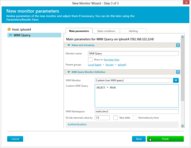With IPHost Network Monitor you can run WMI Power Management Capabilities monitoring of various devices in your network.
To create a WMI monitor for Power Management Capabilities, provide host name (it must be a Windows host) and specify custom WQL query:

Indicates the specific power-related capabilities of the logical device. The array values, 0="Unknown", 1="Not Supported" and 2="Disabled" are self-explanatory. The value, 3="Enabled" indicates that the power management features are currently enabled but the exact feature set is unknown or the information is unavailable. "Power Saving Modes Entered Automatically" (4) describes that a device can change its power state based on usage or other criteria. "Power State Settable" (5) indicates that the SetPowerState method is supported. "Power Cycling Supported" (6) indicates that the SetPowerState method can be invoked with the PowerState input variable set to 5 ("Power Cycle"). "Timed Power On Supported" (7) indicates that the SetPowerState method can be invoked with the PowerState input variable set to 5 ("Power Cycle") and the Time parameter set to a specific date and time, or interval, for power-on.
The Win32_DiskDrive class represents a physical disk drive as seen by a computer running the Win32 operating system. Any interface to a Win32 physical disk drive is a descendent (or member) of this class. The features of the disk drive seen through this object correspond to the logical and management characteristics of the drive. In some cases, this may not reflect the actual physical characteristics of the device. Any object based on another logical device would not be a member of this class. Example: IDE Fixed Disk.
IPHost Network Monitor is an advanced and easy tool for monitoring LAN and WAN networks, network servers, workstations and TCP/IP devices. Use IPHost Network Monitor to monitor your servers, domains, computers and devices.

